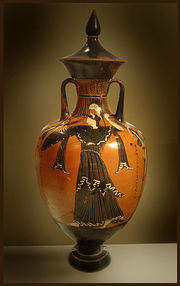Amphora



Key : 1 : rim - 2 : neck - 3 : handle - 4 : shoulder - 5 : belly or body - 6 : foot
An amphora (plural: amphorae or amphoras) is a type of ceramic vase with two handles and a long neck narrower than the body. The word amphora is Latin, derived from the Greek amphoreus (αμφορεύς), an abbreviation of amphiphoreus (αμφιφορεύς), a compound word combining amphi- ("on both sides", "twain") plus phoreus ("carrier"), from pherein ("to carry"), referring to the vessel's two carrying handles on opposite sides.[1]
Contents |
History
Amphora dated to around 4800 BCE have been found in Banpo, a Neolithic site of the Yang Shao Culture in China. In the West, Amphorae first appeared on the Syrian coast around 3500 BCE and spread around the ancient world, being used by the ancient Greeks and Romans as the principal means for transporting and storing grapes, olive oil, wine, oil, olives, grain, fish, and other commodities. They were produced on an industrial scale from Greek times and used around the Mediterranean until about the 7th century. Wooden and skin containers seem to have supplanted amphorae thereafter.
They are of great benefit to maritime archaeologists, as amphorae in a shipwreck can often indicate the age of the wreck and geographic origin of the cargo. They are occasionally so well preserved that the original contents are still present, providing invaluable information on the eating habits and trading systems of the ancient Mediterranean peoples. Amphorae were too cheap and plentiful to return to their origin-point and so, when empty, they were broken up at their destination. In Rome this happened in an area named Testaccio, close to Tiber, in such a way that the fragments, later wetted with Calcium hydroxide (Calce viva), remained to create a hill now named Monte Testaccio 45 meters tall and more than 1 km circumference.
High-quality painted amphorae were produced in significant numbers for a variety of social and ceremonial purposes. Their design differs significantly from the more functional versions; they are typified by wide mouth and a ring base, with a glazed surface and decorated with figures or geometric shapes. Such amphorae were often used as prizes. Some examples, bearing the inscription "I am one of the prizes from Athens", have survived from the Panathenaic Festivals held between the 6th century BC to the 2nd century BC. Painted amphorae were also used for funerary purposes. The loutrophoros, a type of amphora, was used principally for funeral rites. Outsize vases were also used as grave markers, while some amphorae were used as containers for the ashes of the dead.

Forms and sizes
Two principal types of amphorae existed: the neck amphora, in which the neck and body meet at a sharp angle; and the one-piece amphora, in which the neck and body form a continuous curve. Neck amphorae were commonly used in the early history of ancient Greece but were gradually replaced by the one-piece type from around the 7th century BC onwards. Most were produced with a pointed base to allow them to be stored in an upright position by being partly embedded in sand or soft ground. This also facilitated transport by ship, where the amphorae were tightly packed together, with ropes passed through their handles to prevent breaking or toppling during a rough sea voyage.
Amphorae varied greatly in height. The largest could stand as much as 1.5 metres (5 ft) high, while some were under 30 centimetres (12 in) high - the smallest were called amphoriskoi (literally "little amphorae"). Most were around 45 centimetres (18 in) high. There was a significant degree of standardisation in some variants; the wine amphora held a standard measure of about 39 litres (41 US qt), giving rise to the amphora quadrantal as a unit of measure in the Roman Empire. In all, around 66 distinct types of amphora have been identified.
See also
- Ancient Roman pottery
- Carinate
- Lionel Casson, scholar of the contents of shipwrecked amphorae
- Maritime archaeology
- Monte Testaccio
- Pottery of Ancient Greece
- Stirrup jar, a two-handled amphora whose opposing handles connect the aperture to the sides of the vessel
References
- ↑ Göransson, Kristian: The transport amphorae from Euesperides: The maritime trade of a Cyrenaican city 400-250 BC, Acta Archaeologica Lundensia, Series in 4o No. 25, Lund/Stockholm 2007, 9.
External links
- RPM Nautical Foundation
- Bulletin amphorologique
- Amphora Types According to Dressel
- The amphoras project
- Google map of Testaccio
Further reading
- "Amphora" The Concise Oxford Dictionary of Archaeology. Timothy Darvill. Oxford University Press, 2002.
- "Amphora." Encyclopædia Britannica. 2006
|
|||||||||||||||||||||||